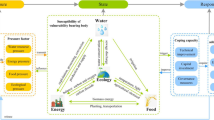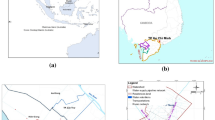Abstract
Vulnerability of water environmental is defined as a measure of the degree of water pollution and its susceptibility and resilience under the influence of both human activities and natural causes. Analysis in this study indicates that water environment in a humid and intensive human activity area such as Southern China is more vulnerable to water quality than to water quantity. The vulnerability of water environment is the key element of water security in these regions. This study provided a new approach to quantify the vulnerability of surface water environment in humid areas through a case study in Southern China. Taking the pollution of water environment as an input–output process, the classic Data Envelopment Analysis method (DEA) which has often been used in the management science, was introduced to establish an evaluation model to access the vulnerability of surface water environment. The analysis results for the 7 water resources districts in the Pearl River Basin of China using the SEA method showed that majority of these water resources districts have abundant water resources, greater carrying capacity, and less vulnerable to shortage of water resources and contamination of water environment.



Similar content being viewed by others
Abbreviations
- Vulnerability of Surface Water Environment:
-
Vulnerable characteristics to damage from human activities or natural factors and the degree of difficulty in restoring it to its original state and function after being damaged.
- Sensitivity of Water Resources System:
-
Responsiveness of water resources system to external stimuli environment
- Water Resources Exposure:
-
State of being exposed
- Water Resources Adaptive Capacity:
-
Ability to change to suit different environment change
- Water Resources Pressure Index:
-
Ratio between water consumption and total available water resources
- DRASTIC:
-
A method for evaluating groundwater resources vulnerability. DRASTIC method is based on seven parameters: depth of water-table net-recharge, aquifer media, soil media, topography, impact of the vadose, hydraulic conductivity of the aquifer.
- GOD:
-
A method for evaluating groundwater resources vulnerability. GOD method is based on three parameters: groundwater confinement overlying strata, and depth to groundwater.
- SINTACS:
-
A method for evaluating groundwater resources vulnerability. SINTACS method is based on seven parameters: depth to groundwater effective infiltration action, unsaturated zone attenuation capacity, soil/overburden attenuation capacity, hydrogeologic characteristics of the aquifer, hydraulic conductivity range of the aquifer, and hydrologic role of the topographic slope
- EPIK:
-
A method for evaluating groundwater resources vulnerability. EPIK method is based on parameters: epikarst protective cover, infiltration condition, and karst network development.
- DEA:
-
Data envelopment analysis a systematic analysis method in management science
- DMU:
-
Decision-making unit is the water resources districts in this paper.
- θ :
-
Vulnerability index
- x :
-
Input variables sewage discharge and surface water resources in this paper.
- y :
-
Output variables reach length of water quality inferior to Class III in this paper
- u :
-
Weight of input variables
- w :
-
Weight of output variables
- PRB:
-
The Pearl River Basin
- Polluted River Reach:
-
Reach length of water quality inferior to Class III (Chinese Standard of Surface Water Quality GB3838-2002)
References
Acosta IR, Martínez MJM (2014) Assessment of surface runoff vulnerability to climate change in the Lerma-Chapala Basin, Mexico. J Water Resour Plan Manag 140(12):1
Alessa L, Kliskey A, Busey R et al (2008) Freshwater vulnerabilities and resilience on the Seward Peninsula: integrating multiple dimensions of landscape change. Glob Environ Chang Hum Policy Dimens 18(2):256–270
Almeida WA, Moreira MC, da Silva DD (2014) Applying water vulnerability indexes for river segments. Water Resour Manag 28(12):4289–4301
Alsharif KA, Fouad G (2012) Lake performance differences in response to land use and water quality: data envelopment analysis. Lake Reservoir Manage 28(2):130–141
Armengol S, Sanchez-Vila X, Folch A (2014) An approach to aquifer vulnerability including uncertainty in a spatial random function framework. J Hydrol 517:889–900
Bär R, Rouholahnedjad E, Rahman K et al (2015) Climate change and agricultural water resources: a vulnerability assessment of the black sea catchment. Environ Sci Pol 46:57–69
Brindha K, Elango L (2015) Cross comparison of five popular groundwater pollution vulnerability index approaches. J Hydrol 524:597–613
Charnes A, Cooper WW, Rhodes E (1978) Measuring the efficiency of decision making units. Eur J Oper Res 2:429–444
Charnes A, Cooper WW, Rhodes E (1981) Evaluation program and managerial efficiency: an application of data envelopment analysis to program follow through. Manag Sci 27(6):668–697
Chen ZH, Zhu ZH, Yin L et al (2015) The changing water quality characteristics from urban drinking water sources in Guangdong, China. Water Resour Manag 29(4):987–1002
de Grosbois D, Plummer R (2015) Problematizing water vulnerability indices at a local level: a critical review and proposed solution. Water Resour Manag 29(14):5015–5035
Dedewanou M, Binet S, Rouet JL et al (2015) Groundwater vulnerability and risk mapping based on residence time distributions: spatial analysis for the estimation of lumped parameters. Water Resour Manag 29(15):5489–5504
Ducci D, Sellerino M (2013) Vulnerability mapping of groundwater contamination based on 3D lithostratigraphical models of porous aquifers. Sci Total Environ 447:315–322
Farley KA, Tague C, Grant GE (2011) Vulnerability of water supply from the Oregon Cascades to changing climate: linking science to users and policy. Glob Environ Chang 21(1):110–122
Fijani E, Nadiri AA, Moghaddam AA et al (2013) Optimization of DRASTIC method by supervised committee machine artificial intelligence to assess groundwater vulnerability for Maragheh–Bonab plain aquifer, Iran. J Hydrol 503:89–100
Ghazavi R, Ebrahimi Z (2015) Assessing groundwater vulnerability to contamination in an arid environment using DRASTIC and GOD models. Int J Environ Sci Technol 12(9):2909–2918
Gleick PH (2015) On methods for assessing water-resource risks and vulnerabilities. Environ Res Lett 10(11)
Hamouda MA, El-Din MMN, Moursy FI (2009) Vulnerability assessment of water resources systems in the Eastern Nile basin. Water Resour Manag 23(13):2697–2725
Jun KS, Chung ES, Sung JY et al (2011) Development of spatial water resources vulnerability index considering climate change impacts. Sci Total Environ 409(24):5228–5242
Kazakis N, Voudouris KS (2015) Groundwater vulnerability and pollution risk assessment of porous aquifers to nitrate modifying the DRASTIC method using quantitative parameters. J Hydrol 525:13–25
Larson KL, Polsky C, Gober P et al (2013) Vulnerability of water systems to the effects of climate change and urbanization: a comparison of Phoenix, Arizona and Portland, Oregon (USA). Environ Manag 52(1):179–195
Li RP, Merchant JW (2013) Modeling vulnerability of groundwater to pollution under future scenarios of climate change and biofuels-related land use change: a case study in North Dakota, USA. Sci Total Environ 447:32–45
Liu BJ, Chen XH, Lian YQ et al (2013a) Entropy-based assessment and zoning of rainfall distribution. J Hydrol 490:32–40
Liu BJ, Chen JF, Chen XH et al (2013b) Uncertainty in determining extreme precipitation thresholds. J Hydrol 503:233–245
Liu YY, Sun CZ, Xu SG (2013) Eco-efficiency assessment of water systems in China. Water Resour Manag 27(14):4927–4939
Lubianetzky TA, Dickson SE, Guo Y (2015) Proposed method: incorporation of fractured rock in aquifer vulnerability assessments. Environ Earth Sci 74(6):4813–4825
Mirauda D, Ostoich M (2011) Surface water vulnerability assessment applying the integrity model as a decision support system for quality improvement. Environ Impact Assess Rev 31(3):161–171
Ouedraogo I, Defourny P, Vanclooster M (2016) Mapping the groundwater vulnerability for pollution at the pan African scale. Sci Total Environ 544:939–953
Pacheco FAL, Fernandes LFS (2013) The multivariate statistical structure of DRASTIC model. J Hydrol 476:442–459
Pear River Water Resources Commission of the Ministry of Water Resources of China (2003–2010) Pearl River Water Resources Bulletin. Guangzhou
Perveen S, James LA (2011) Scale invariance of water stress and scarcity indicators facilitating cross-scale comparisons of water resources vulnerability. Appl Geogr 31(1):321–328
Plummer R, de Loë R, Armitage D (2012) A systematic review of water vulnerability assessment tools. Water Resour Manag 26(15):4327–4346
Sekhar M, Shindekar M, Tomer SK et al (2013) Modeling the vulnerability of an urban groundwater system due to the combined impacts of climate change and management scenarios. Earth Interact 17(10):1–25
Shrestha S, Semkuyu DJ, Pandey VP (2016) Assessment of groundwater vulnerability and risk to pollution in Kathmandu Valley, Nepal. Sci Total Environ 556:23–35
Sullivan CA (2010) Quantifying water vulnerability: a multi-dimensional approach. Stoch Env Res Risk A 25(4):627–640
Varis O, Kummu M (2012) The major Central Asian River Basins: an assessment of vulnerability. Int J Water Resour Dev 28(3):433–452
Vorosmarty CJ, Green P, Salisbury J et al (2000) Global water resources: vulnerability from climate change and population growth. Science 289(5477):284–288
Wei YM, Fan Y, Lu C et al (2004) The assessment of vulnerability to natural disasters in China by using the DEA method. Environ Impact Assess Rev 24:427–439
Wu GY, Li LH, Ahmad S et al (2013) A dynamic model for vulnerability assessment of regional water resources in arid areas a case study of Bayingolin, China. Water Resour Manag 27(8):3085–3101
Xia J, Qiu B, Pan Li YY (2012) Water resources vulnerability and adaptive management in the Huang, Huai and Hai river basins of China. Water Int 37(5):523–536
Yu XJ (2015) Environmental effects under China’s western development strategy: a case study in the Beipan River basin, Guizhou. Int J Environ Stud 72(1):132–145
Zhang B, Li GX, Cheng P et al (2016) Landfill risk assessment on groundwater based on vulnerability and pollution index. Water Resour Manag 30(4):1465–1480
Acknowledgments
The research is financially supported by the National Natural Science Foundation of China (Grant No. 91547202, 51210013, 51479216), the National Science and Technology Support Program (Grant No 2012BAC21B0103), the Public Welfare Project of Ministry of Water Resources (Grant No.201201094, 201301002-02), the project for Creative Research from Guangdong Water Resources Department (Grant No. 2011-11). Our cordial gratitude also should be owed to the Editors-in-Chief, Dr. George P. Tsakiris, and the anonymous reviewers for their professional and pertinent suggestions and comments, which are greatly helpful for further improvements of the quality of this manuscript.
Author information
Authors and Affiliations
Corresponding author
Rights and permissions
About this article
Cite this article
Xiang, Z., Chen, X. & Lian, Y. Quantifying the Vulnerability of Surface Water Environment in Humid Areas Base on DEA Method. Water Resour Manage 30, 5101–5112 (2016). https://doi.org/10.1007/s11269-016-1471-y
Received:
Accepted:
Published:
Issue Date:
DOI: https://doi.org/10.1007/s11269-016-1471-y




